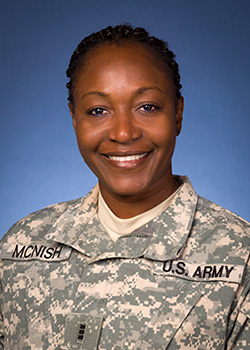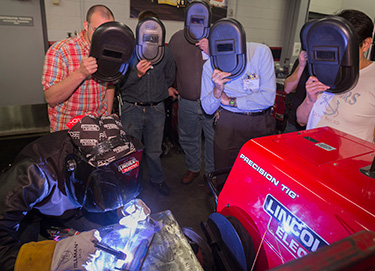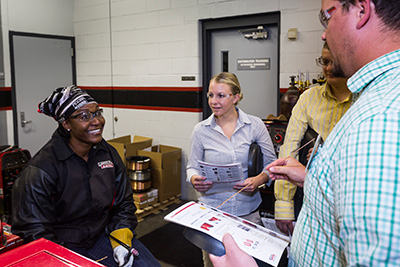U.S. Army Chief Warrant Officer and Welder: Stacey-Ann McNish-Rodriguez
A Different Path
Stacey-Ann McNish-Rodriguez is a chief warrant officer in the U.S. Army... and she is a welder
"With all the new processes learned here, I can take those back to the Army and improve on the training for the Allied Trades Specialist program."
Welding and the Army: either career is relatively uncommon for a woman; to combine the two together is rarer still. To Stacey-Ann McNish-Rodriguez, welding in the U.S. Army is the perfect combination.
That fascination would lead her to her career calling. At 15, Stacey-Ann arrived in southern Florida from Jamaica. After high school, not sure of what she wanted to study and concerned with education costs, Stacey-Ann met with an Army recruiter. He mentioned welding as a potential service occupation, and she was sold. Why welding?
“I was fascinated with the welding process because I love to create things,” Stacey-Ann says.
So, in February 1994, she enlisted in the U.S. Army as an Allied Trades Specialist. Now, almost 20 years later, CW3 McNish-Rodriguez directs the setup, operation and maintenance of machine tools and welding equipment used to fabricate or repair parts, mechanisms, tools and machinery.
“I will be in charge, training officers and other warrant officers,” she explains, describing her next assignment at the Army’s Fort Lee in Virginia.
During four combat deployments, Stacey-Ann has witnessed just how welding can play an important role in Army operations.
“Welding is a critical occupational specialty in the Army, and during those deployments it seemed that the welding shop had more work than everyone else,” she says, noting that the majority of deployment work involved recovery and repair of damaged vehicles. “When something gets blown up or needs repair, we handle that, and it all must be done quickly. And sometimes we add metal or modify equipment. When a soldier comes in for you to make something new or to repair something, I see it as an art project. It’s a type of art form that I really enjoy and appreciate.”
First Warrant Officer in Welding-Industry Training Program
To keep up with the latest welding technology and procedures, Stacey-Ann has been training for the past 12 months at the Lincoln Electric Co. in Cleveland. For the past five years, Lincoln Electric has participated in the U.S. Army’s Training With Industry (TWI) program, where an enlisted Army soldier reports to work at Lincoln Electric for one year. During this period, the soldier gains knowledge in order to advance welding practices in the military. The program has been so successful at Lincoln Electric that it has been expanded to include a warrant officer. Stacey-Ann is the first to participate.
“Being selected as the first Warrant Officer in the Allied Trades field to fill this position is a definite honor,” says Stacey-Ann, who completes her assignment in July before heading back to Fort Lee.
“In this program, competitively selected officers are given extensive work exposure to corporate America,” explains Carl Peters, director of technical training at Lincoln Electric. “The officer gains knowledge in welding and private-sector business practices and procedures, and then reports back to a military position for three years in order to transfer the knowledge.”
During her time at Lincoln Electric, Stacey-Ann has participated in welding-design and welding-productivity seminars, training in advanced robotics and Six Sigma operational analysis, and a comprehensive welding course, as well as advanced-technology training and exposure to various types of Lincoln Electric welding equipment. She also earned multiple welding certifications.
Army Gains from Industry Knowledge
“The Army’s main objective in sponsoring the TWI program is to develop soldiers who are experienced in higher-level managerial techniques and who have an understanding of the relationship of their industry as it relates to specific functions of the Army,” explains Stacey-Ann. “Once TWI students integrate back into an Army organization, they can use this information to improve the Army’s ability to interact and conduct business with industry. Participants may also be exposed to innovative industrial-management practices, techniques and procedures that are applicable to, and benefit, the Army.”
But there is much more to the program than that, according to Stacey-Ann.
“I see the relationship between Lincoln Electric and the Army welder as far more than just a partnership,” she says. “The level of professionalism and top management practices here at Lincoln Electric can be of great benefit to the Army. Lincoln Electric is a whole new world. Every day I am amazed at all of the things I see here in relation to research and the level of technology and technical expertise. With all the new processes learned here, I can take those back to the Army and improve on the training for the Allied Trades Specialist program.”
Advanced robotic training and the use of Lincoln Electric’s VRTEX® virtual reality welding training systems are two examples of Stacey-Ann’s Lincoln Electric experience that translate well to Army needs.
“The advanced robotic training shows how the welding world is evolving and brings to mind ideas of how to accomplish many of the Army’s welding needs,” she offers, noting also that the VRTEX® system is so effective in training new welders that the Army has added 13 of these innovative teaching aids to its Allied Trades Department at Fort Lee’s Center of Excellence.
Also impressive at Lincoln Electric? The teachers and course content, according to Stacey-Ann.
“The instructors at Lincoln Electric are true professionals, and the best in the business of welding,” she offers. “My immediate supervisor, Carl Peters, made sure I was fully involved in all of the available classes and seminars--keeping the Army’s goal in mind. We are trying to develop our welding curriculum in the Army so that when soldiers leave they can be competitive on the outside, and the courses and instructors at Lincoln Electric enable us to do that.”
Perseverance Pays
With her training at Lincoln Electric winding down, Stacey-Ann is set to bring a host of new ideas back to Fort Lee. But what won’t change is the attitude that enabled her to succeed as a female welder and chief warrant officer in the U.S. Army.
“Being in the Army as a female and an Allied Trades warrant officer has its challenges, as in any profession,” she explains. “You need to ask yourself whether you will allow any small minds and challenges to dictate your career path for you. I have always been a strong, persistent individual, never allowing anyone or anything to control what is attainable. When I tell people what I do, they look at me and say, ‘That is not possible.’ The opportunities are there for females, but if you are not on top of performance and knowledge, it will not work out. You have to prove yourself every day.
“My motto has always been to go for the challenge,” Stacey-Ann adds. “Never allow another human being to dictate how much you can achieve.”
Go for the challenge she did, and looking back she knows she’s made the right decisions.
“My overall Army career has been fun,” Stacey-Ann concludes. “Four deployments to Iraq, two beautiful kids that are simply amazing, a wonderful husband and family support that is stupendous.”



